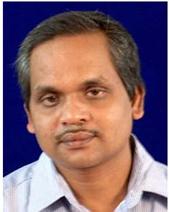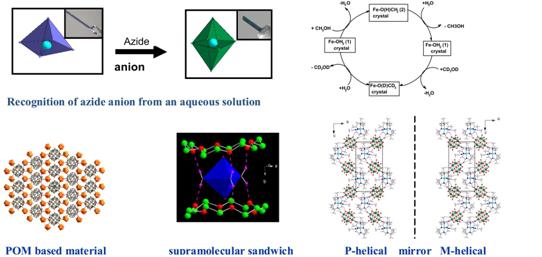










|
Title of Talk Inorganic Supramolecular Chemistry: A Simple Mono-nuclear Copper Coordination Complex to Tri-nuclear Iron Cluster Through Multinuclear Polyoxometalates
Abstract In “Inorganic Supramolecular Chemistry”, the self-assembly through metal coordination has shown remarkable potential for the construction of well-defined architectures. The use of supramolecular interactions in the creation of new types of functional materials with interesting properties is a challenging task in contemporary chemical research. In the course of our supramolecular research, we are working towards the construction of supramolecular functional systems that have potential applications. In the first part of this talk, molecular recognition of azide anion from an aqueous solution through a solid-to-solid (crystal-to-crystal) transformation at a solid-liquid interface, will be described based on the conversion of a mono-nuclear copper coordination complex to chiral coordination polymer.1 In the second part, a gas-solid reaction in a single crystal to single crystal transformation would be discussed in the context of molecular recognition of methanol from its vapor state at an ambient condition, mediated by a tri-nuclar iron cluster containing compound.2 Finally supramolecular aspects of polyoxometalate (POM) chemistry will be mentioned under following headings: the linking propensity of some well-defined POM clusters to obtain metal-oxide based new materials;3-4 the co-existence of some crown ethers and POM cluster anions, in which it will be demonstrated that POM cluster anions play an important role in stabilizing unusual supramolecular structures;5 role of Keggin-type heteropolyanion in the self assembly of metal phosphonate architectures and how a POM cluster influences chiral separation through spontaneous resolution;6 the chemistry of a giant POM cluster in an aqueous solution at higher temperature leading to the formation of a nano-material.7
Figure 1. A passive organic waveguide with two out-puts in action.
References: 1. Sabbani Supriya and Samar K. Das, Chem. Commun., 2011, 47, 2062 2. Sabbani Supriya and Samar K. Das, J. Am. Chem. Soc. 2007, 129, 3464 3. Vaddypally Shivaiah, M. Nagaraju and Samar K. Das, Inorg. Chem., 2003, 42, 6604 4. T. Arumuganathan and Samar K. Das, Inorg. Chem., 2009, 48, 496 5. Vaddypally Shivaiah and Samar K. Das, Angew. Chem., Int. Ed. 2006, 45, 245 6. Manima Sarma, Tanmay Chatterjee and Samar K. Das, Dalton Trans. 2012, 41, 1862 7. Raju Mekala, Sabbani Supriya and Samar K. Das, Inorg. Chem., 2013, 52, 9708 |
|
Samar K. Das, Professor
School of Chemistry, University of Hyderabad, Hyderabad-500046 INDIA e-mail: skdsc@uohyd.ernet.in
B.Sc., Burdwan University, India, 1985 M.Sc., University of Kalyani, 1987 Ph.D., IIT Kanpur, 1995 Postdoctoral fellow: Department of Chemistry, The Ohio State University, Ohio, USA, 1998; Anorg. Chim. I, Universitaet Bielefeld, Germany, 2000; Alexander von Humboldt Fellow, Anorg. Chim. I, Universitaet Bielefeld, Germany, 2004. Professor, School of Chemistry, University of Hyderabad, 2009-present; Reader, School of Chemistry, University of Hyderabad, 2004-2009; Lecturer, School of Chemistry, University of Hyderabad, 2000-2004. Elected Fellow of Indian Academy of Science, Bangalore (FASc), 2010. Bronze Medal – 2010 (by Chemical Research Society of India). More than 125 research publications in international journals and trained 12 Ph.D students. Metal-oxide based materials and their supramolecular chemistry; polyoxometalate chemistry, dithiolene-based compounds as functional materials; transition metal coordination complexes exhibiting sensing and photo-physical properties are the research area.
|

